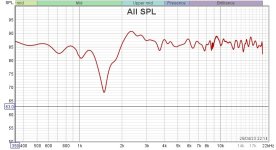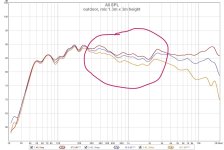The gate is for indoor measurements. I suspect that something is wrong with the crossover. Can you take impedance measurements? Unfortunately, I can't do anything with the results of the oscilloscope.
Last edited:
This just came out:
It's a nice introduction into speaker measurements and results, although your latest questions are not answered...
It's a nice introduction into speaker measurements and results, although your latest questions are not answered...
The horn is connected as per recommended polarity.Maybe the 1 kHz dip is a phase issue. The horn crossover output is out of phase with the amp input at that frequency. Try reversing the wires to the horn.
+Horn to the amplifier out -.
-Horn to the crossover horn out .
I will try to reverse the polarity.
Last edited:
I will measure all crossover components.The gate is for indoor measurements. I suspect that something is wrong with the crossover. Can you take impedance measurements? Unfortunately, I can't do anything with the results of the oscilloscope.
I don't know if scope results are useful but looking at those you can see that the voltage out is significantly lower at the same frequencies where the deep is.
Well, just try reversing the horn wires and see what the graph looks like, i can clearly see a phase shift on your direct vs crossover pics, you suppose to see the 2 waveforms in top of each other (in phase) , your pics show out of phase crossover signal compared to the source clean signal.
Ok, that means it was right before the "test", ok put the wires back the way it was, so what i can think of is time smear at your XO point, i wish you had DSP and 2 channels of amplifier so we can time align the 2 drivers , somehow your crossover is shifting the phase and that's why you have the dip in the 1st graph before you swapped the polarity, looks like some cancellation by phase smear.
Can't tell if that is your exact case but, recheck your crossover for accuracy, is easy to mess up a connection or 2.
Try with another known good crossover even that the XO point is not the same.
You suppose to have superimposed graph on the scope...at least almost identical.
And they are not, check for crossover build errors, or parts values off.
My 2 cents.
Can't tell if that is your exact case but, recheck your crossover for accuracy, is easy to mess up a connection or 2.
Try with another known good crossover even that the XO point is not the same.
You suppose to have superimposed graph on the scope...at least almost identical.
And they are not, check for crossover build errors, or parts values off.
My 2 cents.
I think the horn output level may be a bit high compared to the woofer. Try padding down the output level to the horn.
I have checked the crossover for wrong connections many times.
I have checked components values too.
I haven't measure for components values accuracy yet.
I have checked components values too.
I haven't measure for components values accuracy yet.
Also, there is a peak in the horn response between 2 kHz and 3 kHz which makes the dip at 1 kHz seem worse.
For people wanting reports on how they sound. I've heard them. Rese66 has an uncanny ability to write very accurately, straight, and perfect descriptions and thoughts on these, imo. So what can I really say differently?
In my opinion, he has designed a horn speaker that has all of the positive attributes good horns do, while never once sounding like PA speakers. These are true HiFi sounding horns, which do everything really well. The measurements show this to great effect. This time, you can realize the goodness the measurements point to.
In my opinion, he has designed a horn speaker that has all of the positive attributes good horns do, while never once sounding like PA speakers. These are true HiFi sounding horns, which do everything really well. The measurements show this to great effect. This time, you can realize the goodness the measurements point to.
check with another crossover also...I have checked the crossover for wrong connections many times.
I have checked components values too.
I haven't measure for components values accuracy yet.
check on an open space... your patio or an open field so there is no reflections but the ground.
Maybe mic-position could be an issue? I think you mentioned mic position was 1m away at the height of the horn? What happens if you have the mic height between the centers of the drivers?
"Maybe mic-position could be an issue? I think you mentioned mic position was 1m away at the height of the horn? What happens if you have the mic height between the centers of the drivers?"
I will test for this in the afternoon.
I will test for this in the afternoon.
First, it is really hard to check on your x-over for correct connections. So maybe, even if you think it is right, check again. Two coils may have been interchanged.
Second, it might be a problem with your measuring. Measure outside, have the middle between horn and woofer cone about 1.5m high at least. Microfone also 1.5m high or what ever you can realize with the box. 2-3m measuring distance. Measure LOUD.
If you have another well known, documented chassis or speaker, make a measurement and see if you can get a compareable curve.
Third, the drivers may be out of spec. For some reason Tymphany does not like to sell the the compression driver any more. This makes me think...
Check the woofer. May be it is out of spec too. Start with simple resistance = z-coil DC
Last: Measure each driver allone, but with x-over. Compare to the measurements her:
https://www.der-akustische-untergrund.de/speakers/power-hifi-projects/asathor-preiswerte-männerbox/
Second, it might be a problem with your measuring. Measure outside, have the middle between horn and woofer cone about 1.5m high at least. Microfone also 1.5m high or what ever you can realize with the box. 2-3m measuring distance. Measure LOUD.
If you have another well known, documented chassis or speaker, make a measurement and see if you can get a compareable curve.
Third, the drivers may be out of spec. For some reason Tymphany does not like to sell the the compression driver any more. This makes me think...
Check the woofer. May be it is out of spec too. Start with simple resistance = z-coil DC
Last: Measure each driver allone, but with x-over. Compare to the measurements her:
https://www.der-akustische-untergrund.de/speakers/power-hifi-projects/asathor-preiswerte-männerbox/
Can you measure the input of the speakers just like you did with the output and a microphone? I don't know what equipment you have, but you can feed the input of the speakers to the ADC, but you'll have to make shure that the level is appropriate. I have a small box where I can attenuate the signal and it has two green LED's which limits the amplitude to 1-2 V.
Chop the chain in parts in order to find the problem.
Chop the chain in parts in order to find the problem.
- Home
- Loudspeakers
- Multi-Way
- Asathor - a JBL 4367 Clone

